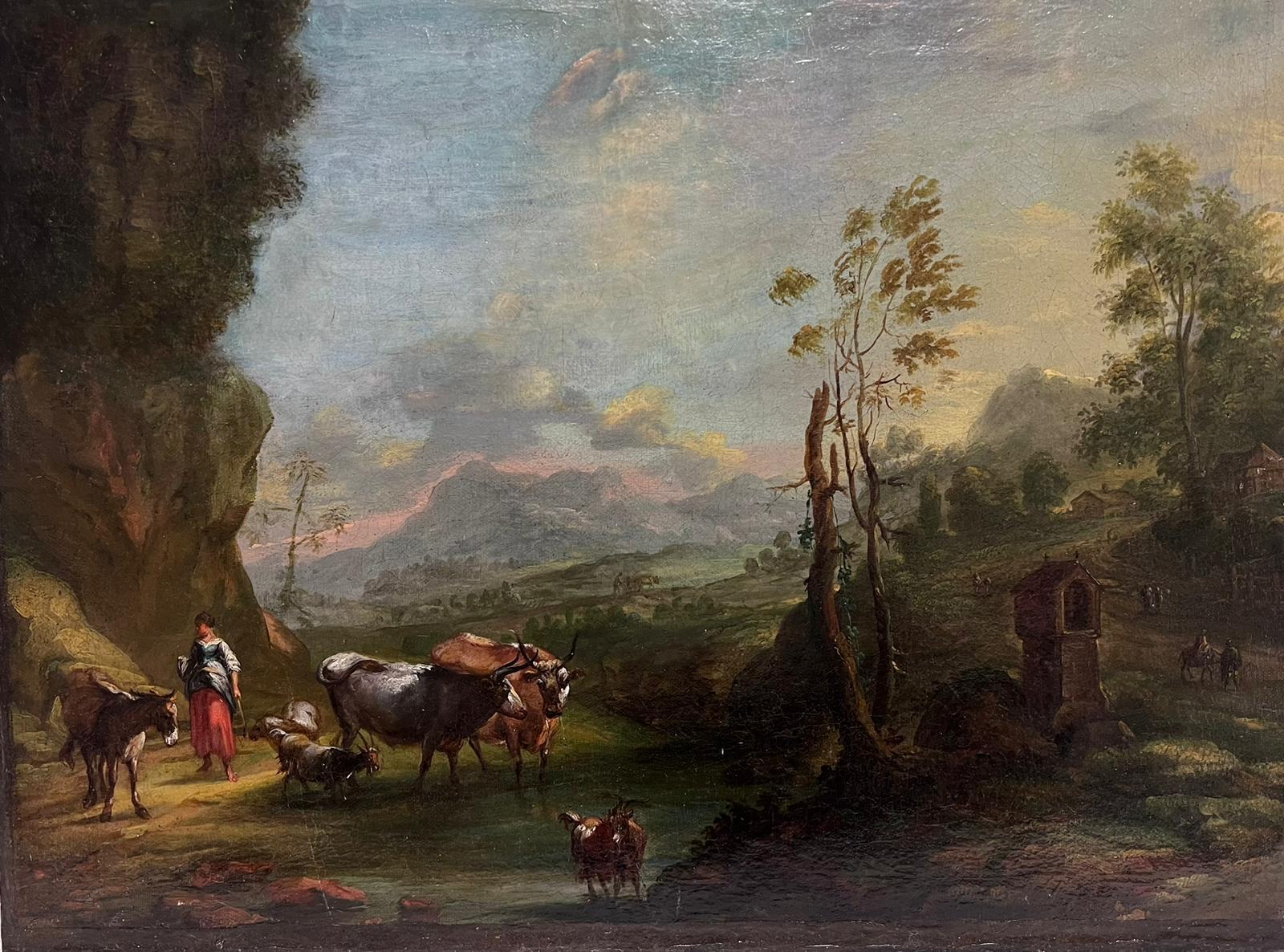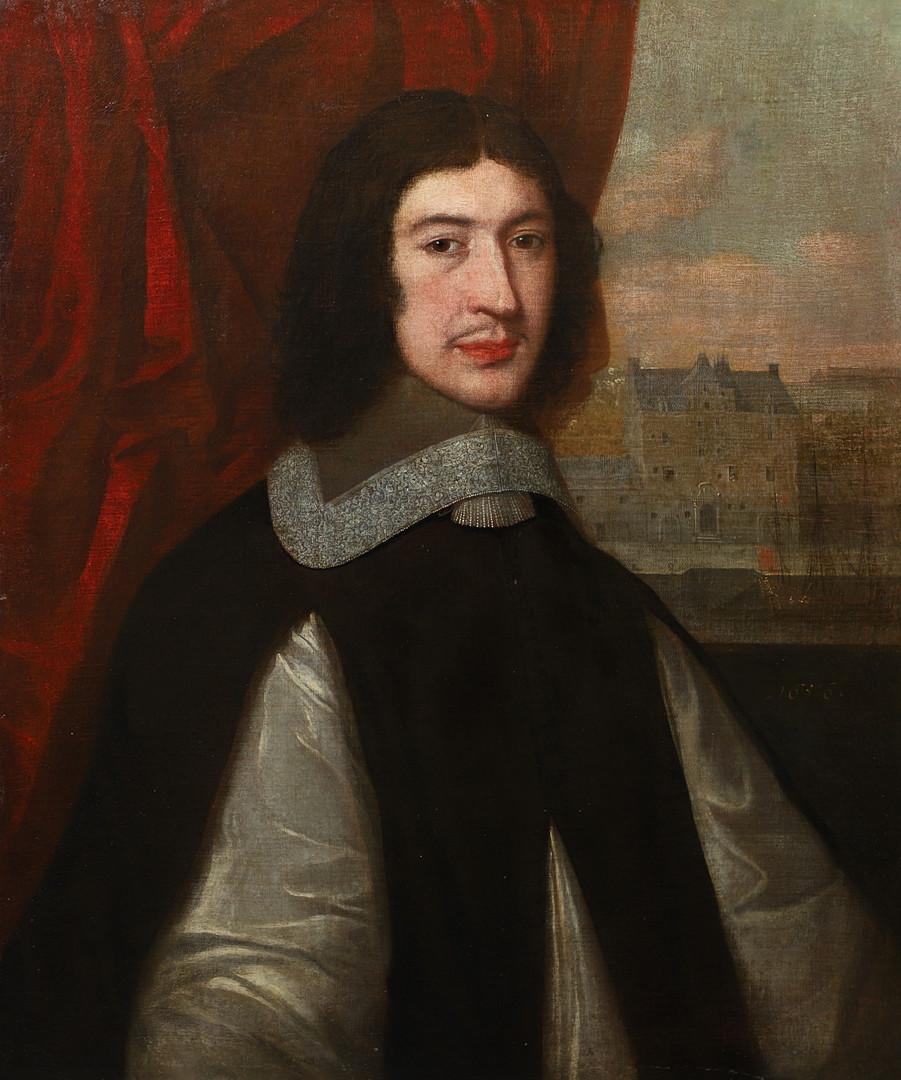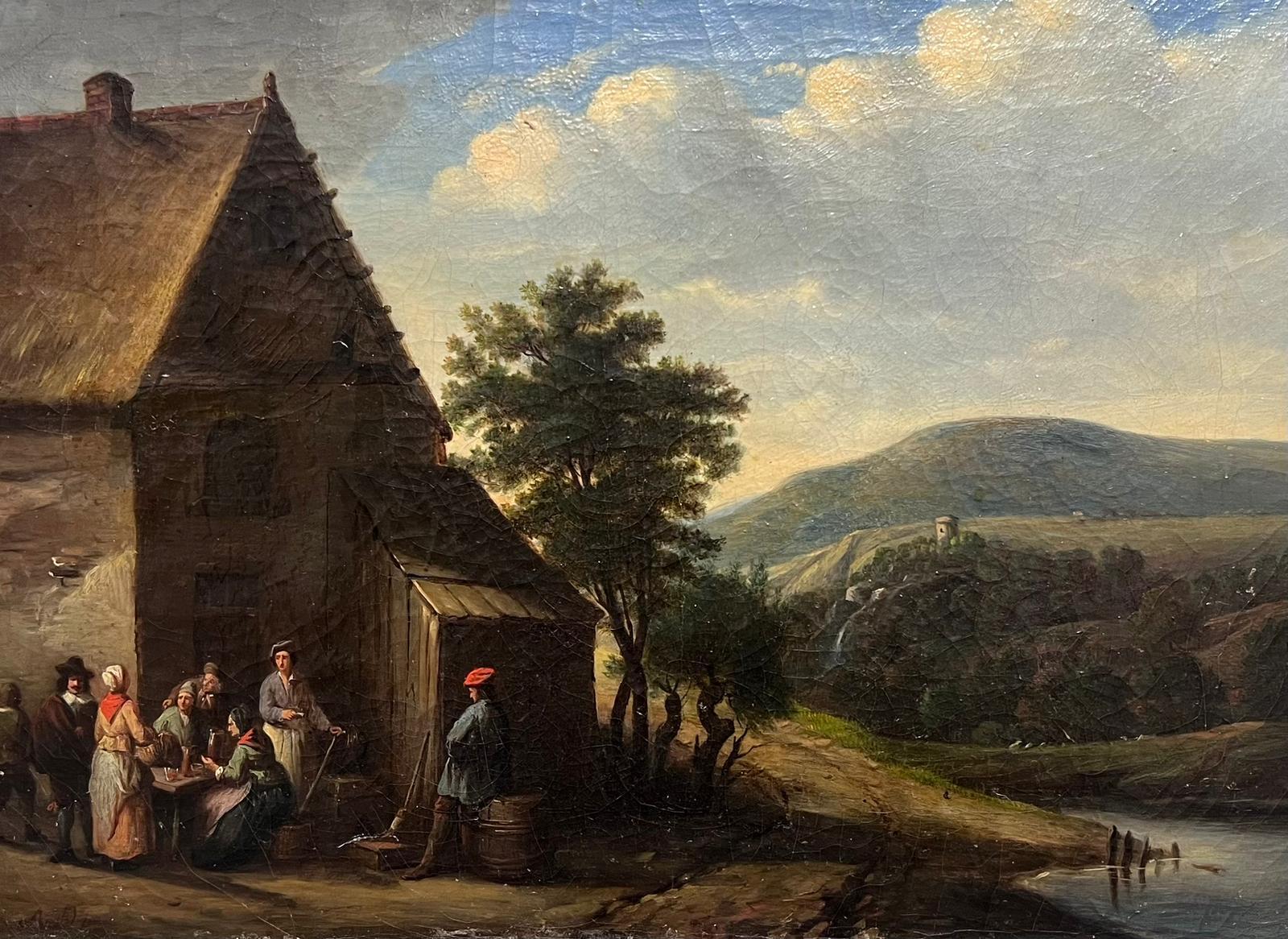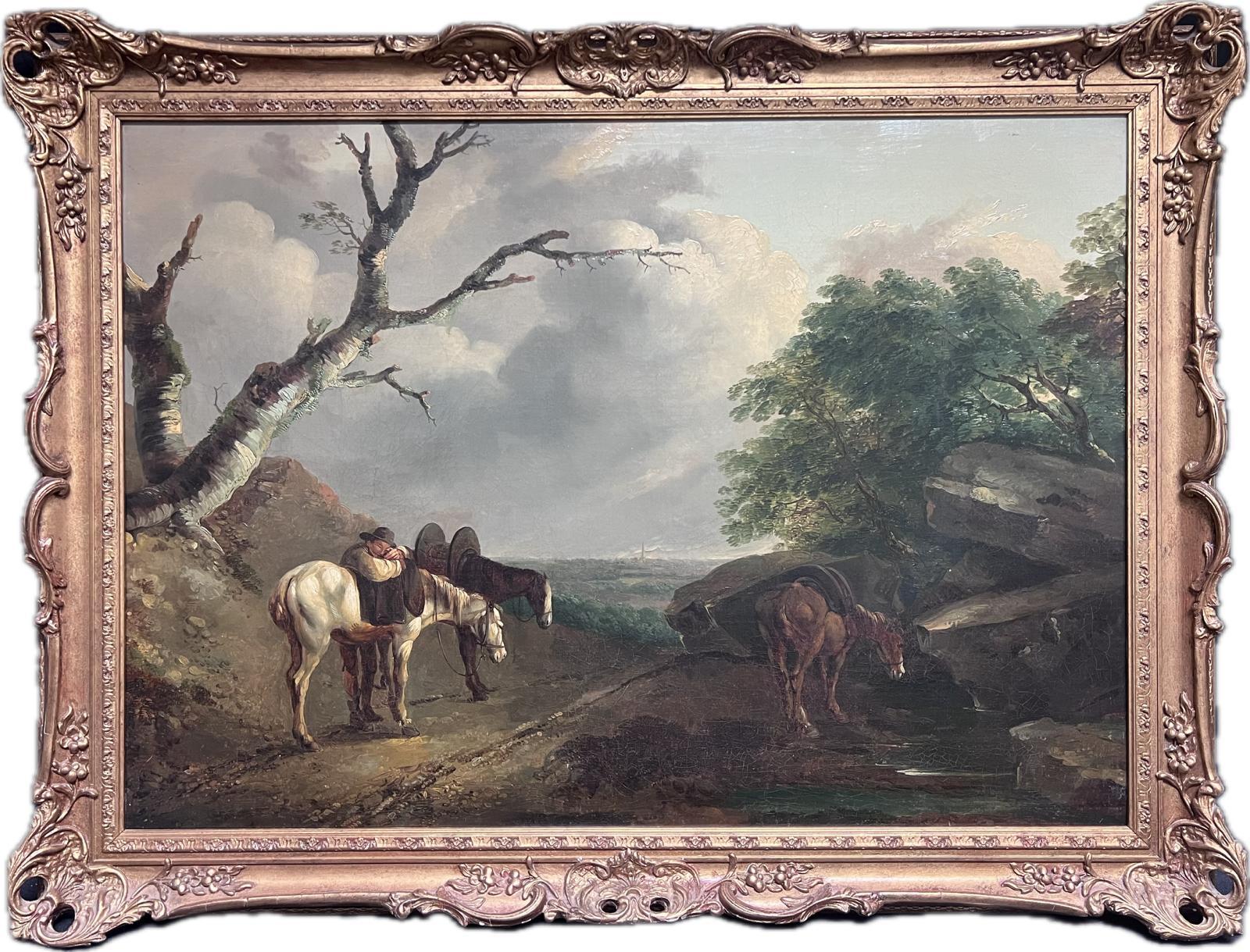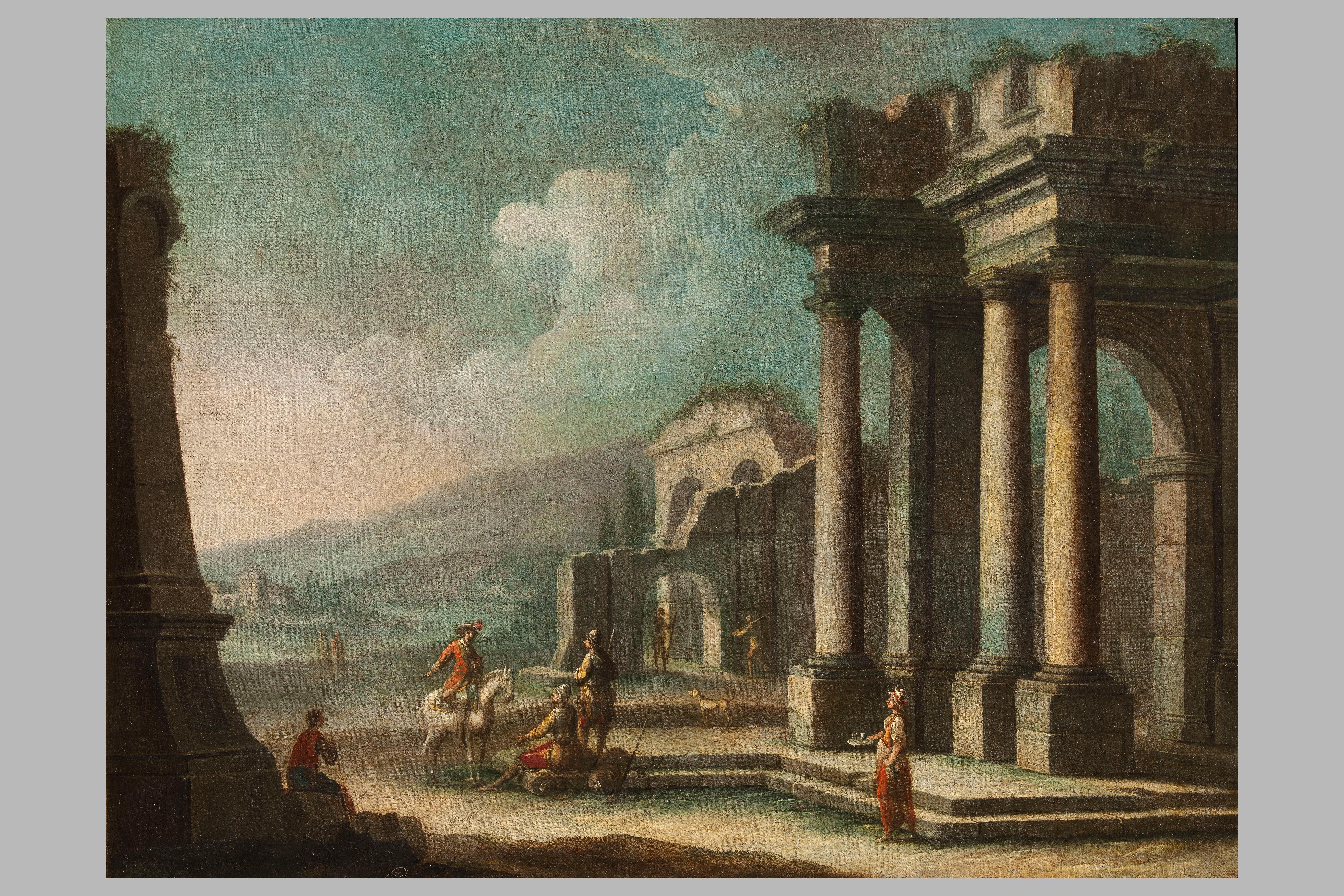Items Similar to 18th Century Galanti Scenes Van Limborch Rest Hunting Oil on Canvas Green Red
Want more images or videos?
Request additional images or videos from the seller
1 of 12
Hendrick van LIMBORCH18th Century Galanti Scenes Van Limborch Rest Hunting Oil on Canvas Green Red
About the Item
Pair of oval paintings measuring 66 x 89 cm without frame and 90 x 115 cm with coeval frame depicting two gallant moments during a rest from hunting by painter Hendrik Van Limborch ( The Hague 1681 - 1759 ).
Beautiful color impact with these light, warm tones that go blending with the peace and tranquility of the rural world.
The main characteristics of Van Limborch's painting are the airy breadth of panoramas and the sense of diffuse brightness where episodes have no precise meaning. They are almost always country pastimes so dear to the 17th century, with the usual characters from the repertoire of the painters of whimsy and views: beggars, Orientals, abbots contemplating ancient tombstones or hunters seeking rest or at work all of course always immersed in nature's unchallenged dominance and symbol of unity between man and life.
The landscape motif even in the most imaginative accents always has in our painter a real cue and therefore a real and human dimension; in these paintings we can see this green so bright and alive that it tries to explain to us how much the nature that is around us and in which we lose ourselves is beautiful, strong, vigorous but at the same time gentle and docile.
Beautiful to note how the two pairs of people are on the one hand busy in their thoughts but at the same time seem lost in the serenity and tranquility of this old-time landscape.
Typical is his construction of the pictorial fabric, and particular is the atmospheric rendering played with the shadowy areas created by the scenic backdrops of trees and clouds.
As is the case in this painting, the perfect composition of the landscape became the main object of his work;
The tree-lined patches executed with free and quick brushstrokes, the warm burnished colors, the atmospheric rendering of the rising cloud mounds, all in a well-balanced composition of his landscapes with an Arcadian pastoral flavor, constitute the most significant elements of his painting, all of which are also well represented in our canvas.
The paintings and art objects published here are my exclusive property and consequently are always available to be viewed in person, by appointment, at my exhibition venues located in San Remo and Brescia.
The work, like any of our items, is sold accompanied by a FIMA photographic certificate of authenticity and lawful provenance; this document identifies the item bringing added value to the item.
We personally handle and organize the packing and shipping of artworks with insurance worldwide.
Dr. Riccardo Moneghini
Storico dell'Arte
- Creator:Hendrick van LIMBORCH (1681 - 1769, Dutch)
- Dimensions:Height: 25.99 in (66 cm)Width: 35.04 in (89 cm)Depth: 1.97 in (5 cm)
- More Editions & Sizes:66 x 89 e con cornice 90 x 115Price: $9,942
- Medium:
- Movement & Style:
- Period:1730-1739
- Condition:
- Gallery Location:Sanremo, IT
- Reference Number:1stDibs: LU1510213736382
About the Seller
5.0
Vetted Seller
These experienced sellers undergo a comprehensive evaluation by our team of in-house experts.
Established in 2013
1stDibs seller since 2021
Typical response time: <1 hour
- ShippingRetrieving quote...Ships From: Sanremo, Italy
- Return PolicyA return for this item may be initiated within 7 days of delivery.
Auctions on 1stDibs
Our timed auctions are an opportunity to bid on extraordinary design. We do not charge a Buyer's Premium and shipping is facilitated by 1stDibs and/or the seller. Plus, all auction purchases are covered by our comprehensive Buyer Protection. Learn More
More From This SellerView All
- 18th Century Winter Landscape Flemish School Snow Nature Oil on Canvas WhiteLocated in Sanremo, ITPainting, oil on canvas, measuring 55 x 35 cm without frame and 66 x 46 cm with a non-coeval frame, initialled at lower left in an unreadable manner, of the Flemish school. The main...Category
Late 18th Century Flemish School Landscape Paintings
MaterialsCanvas, Oil
- 19th Century Square in Cogne Leonardo Bazzaro Bambini Oil on Canvas Orange WhiteLocated in Sanremo, ITPainting, oil on canvas, measuring 100 x 80 cm without frame and 125 x 100 cm with frame depicting the Piazzetta of Cogne by the painter Leonardo Bazzaro, signed and dated 1927. The...Category
1920s Italian School Landscape Paintings
MaterialsCanvas, Oil
- 18th Century Architectural Capriccio Gaetano Vetturali Landscape Oil on CanvasBy Gaetano Vetturali (Lucca, 1701-1783)Located in Sanremo, ITOil painting on canvas measuring 85 x 110 cm without frame and 103 x 126 cm with frame depicting a landscape with figures along the path. In the work in question, depicting a large ...Category
Late 18th Century Italian School Landscape Paintings
MaterialsCanvas, Oil
- 18th Century Landscape Flemish School Nature Wayfarers Oil on Canvas GreenLocated in Sanremo, ITPainting oil on panel measuring 48 x 32 cm without frame and 58 x 43 cm with frame depicting a landscape with figures from the Flemish school of the 18th century. A lively painting ...Category
Mid-18th Century Flemish School Landscape Paintings
MaterialsCanvas, Oil
- 18th Century Landscape Flemish School People and Cows Oil on Canvas GreenLocated in Sanremo, ITFlemish painting measuring 44 x 30 cm without frame and 53 x 39 cm with frame depicting a landscape with figures, in soft tones and with a strong sense of perspective; elegant, fluid...Category
18th Century Flemish School Landscape Paintings
MaterialsCanvas, Oil
- 17th Century Animals Rosa da Tivoli Nature Landscape Oil on Canvas Blue GreenLocated in Sanremo, ITThe "Rural Scene" (oil painting on canvas, 90 x 113 cm without frame and 110 x 125 cm with coeval frame) as it hinges only on the presence of animals - an ox, a cow, two sheep and a goat - may constitute an exception in this specific vein, but it reflects the prevailing and constant practice of Philipp Peter Roos known as "Rosa da Tivoli...Category
Mid-17th Century Italian School Landscape Paintings
MaterialsCanvas, Oil
You May Also Like
- A WolfLocated in New York, NYProvenance: The Marchesi Strozzi, Palazzo Strozzi, Florence Sale, Christie’s, London, May 20, 1993, lot 315, as by Carl Borromaus Andreas Ruthart...Category
17th Century Old Masters Animal Paintings
MaterialsPaper, Canvas, Oil
- Early oil depicting the Great Fire of LondonLocated in London, GBThe Great Fire of London in September 1666 was one of the greatest disasters in the city’s history. The City, with its wooden houses crowded together in narrow streets, was a natural fire risk, and predictions that London would burn down became a shocking reality. The fire began in a bakery in Pudding Lane, an area near the Thames teeming with warehouses and shops full of flammable materials, such as timber, oil, coal, pitch and turpentine. Inevitably the fire spread rapidly from this area into the City. Our painting depicts the impact of the fire on those who were caught in it and creates a very dramatic impression of what the fire was like. Closer inspection reveals a scene of chaos and panic with people running out of the gates. It shows Cripplegate in the north of the City, with St Giles without Cripplegate to its left, in flames (on the site of the present day Barbican). The painting probably represents the fire on the night of Tuesday 4 September, when four-fifths of the City was burning at once, including St Paul's Cathedral. Old St Paul’s can be seen to the right of the canvas, the medieval church with its thick stone walls, was considered a place of safety, but the building was covered in wooden scaffolding as it was in the midst of being restored by the then little known architect, Christopher Wren and caught fire. Our painting seems to depict a specific moment on the Tuesday night when the lead on St Paul’s caught fire and, as the diarist John Evelyn described: ‘the stones of Paul’s flew like grenades, the melting lead running down the streets in a stream and the very pavements glowing with the firey redness, so as no horse, nor man, was able to tread on them.’ Although the loss of life was minimal, some accounts record only sixteen perished, the magnitude of the property loss was shocking – some four hundred and thirty acres, about eighty per cent of the City proper was destroyed, including over thirteen thousand houses, eighty-nine churches, and fifty-two Guild Halls. Thousands were homeless and financially ruined. The Great Fire, and the subsequent fire of 1676, which destroyed over six hundred houses south of the Thames, changed the appearance of London forever. The one constructive outcome of the Great Fire was that the plague, which had devastated the population of London since 1665, diminished greatly, due to the mass death of the plague-carrying rats in the blaze. The fire was widely reported in eyewitness accounts, newspapers, letters and diaries. Samuel Pepys recorded climbing the steeple of Barking Church from which he viewed the destroyed City: ‘the saddest sight of desolation that I ever saw.’ There was an official enquiry into the causes of the fire, petitions to the King and Lord Mayor to rebuild, new legislation and building Acts. Naturally, the fire became a dramatic and extremely popular subject for painters and engravers. A group of works relatively closely related to the present picture have been traditionally ascribed to Jan Griffier...Category
17th Century Old Masters Landscape Paintings
MaterialsCanvas, Oil
- Shipping in Stormy Waters, Attributed to Italian Artist Francesco GuardiBy Francesco GuardiLocated in Stockholm, SEThe splendour of the tragic sea Francesco Guardi and maritime painting in Venetian art No Venetian painter was a stranger to the sea. After all, Venice was not only one of the most prominent ports of the Mediterranean, but indeed a city literally submerged in the ocean from time to time. Curiously however, the famous Venetian school of painting showed little interest in maritime motifs, favouring scenes from the iconic architecture of the city rather than seascapes. That is why this painting is a particularly interesting window into not only the painter Francesco Guardi himself – but to the significance of the element of water in art history, in absence as well as in the centre of attention. Whether it be calm, sunny days with stunning views of the palaces alongside the canals of Venice or – more rarely – stormy shipwrecking tragedies at sea, water as a unifying element is integral to the works of painter Francesco Guardi (1712–1793). During his lifetime, Venetian art saw many of its greatest triumphs with names like Tiepolo or Canaletto gaining international recognition and firmly establishing Venice as one of the most vibrant artistic communities of Europe. While the city itself already in the 18th century was something of an early tourist spot where aristocrats and high society visited on their grand tour or travels, the artists too contributed to the fame and their work spread the image of Venice as the city of romance and leisure to an international audience, many of whom could never visit in person. Still today, the iconic image of Venice with its whimsical array of palaces, churches and other historic buildings is much influenced by these artists, many of whom have stood the test of time like very well and remain some of the most beloved in all of art history. It was not primarily subtility, intellectual meanings or moral ideals that the Venetian art tried to capture; instead it was the sheer vibrancy of life and the fast-paced city with crumbling palaces and festive people that made this atmosphere so special. Of course, Venice could count painters in most genres among its residents, from portraiture to religious motifs, history painting and much else. Still, it is the Vedutas and views of the city that seems to have etched itself into our memory more than anything else, not least in the tradition of Canaletto who was perhaps the undisputed master of all Venetian painters. Born into his profession, Francesco lived and breathed painting all his life. His father, the painter Domenico Guardi (1678–1716) died when Francesco was just a small child, yet both he and his brothers Niccolò and Gian Antonio continued in their fathers’ footsteps. The Guardi family belonged to the nobility and originated from the mountainous area of Trentino, not far from the Alps. The brothers worked together on more challenging commissions and supported each other in the manner typical of family workshops or networks of artists. Their sister Maria Cecilia married no other than the artist Giovanni Battista Tiepolo himself, linking the family to the most renowned Venetian name of the time. During almost a decade, Guardi worked in the studio of Michele Giovanni Marieschi, sometimes simply known as Michiel, a painted similar in both style and motif. Canaletto is, however, the artist Guardi is most often compared to since they shared a mutual fascination for depicting the architecture and cityscape of Venice. During the course of his career, Guardi tried his hand in many different genres. He was as swift in painting landscapes, Vedutas of Venice, sacred motifs, interiors and architectural compositions as he was in a number of other motifs. His style is typical of the Venetian school but also distinct and personal once we look a little closer. There is an absolute certainty in the composition, the choice of which sometimes feels like that of a carefully calculated photograph – yet it is also very painterly, in the best sense of the word: fluid, bold, sensitive and full of character. The brushwork is rapid, intense, seemingly careless and extraordinarily minute at the same time; fresh and planned in a very enjoyable mixture. His interiors often capture the breath-taking spacious glamour of the palaces and all their exquisite decor. He usually constructed the motif through remarkably simple, almost spontaneous yet intuitively precise strokes and shapes. The result was a festive, high-spirited atmospheric quality, far away from the sterile and exact likeness that other painters fell victim to when trying to copy Canaletto. The painting here has nothing of the city of Venice in it. On the contrary, we seem to be transported far away into the solitary ocean, with no architecture, nothing to hold on to – only the roaring sea and the dangerous cliffs upon which the ships are just moments away from being crushed upon. It is a maritime composition evoking both Flemish and Italian precursors, in the proud tradition of maritime painting that for centuries formed a crucial part of our visual culture. This genre of painting is today curiously overlooked, compared to how esteemed and meaningful it was when our relationship to the sea was far more natural than it is today. When both people and goods travelled by water, and many nations and cities – Venice among them – depended entirely on sea fare, the existential connection to the ocean was much more natural and integrated into the imagination. The schools and traditions of maritime art are as manifold as there are countries connected to the sea, and all reflect the need to process the dangers and wonders of the ocean. It could symbolize opportunity, the exciting prospects of a new countries and adventures, prospering trade, beautiful scenery as well as war and tragedy, loss of life, danger and doom. To say that water is ambivalent in nature is an understatement, and these many layers were something that artists explored in the most wondrous ways. Perhaps it takes a bit more time for the modern eye to identify the different nuances and qualities of historic maritime paintings, they may on first impression seem hard to differentiate from each other. But when allowing these motifs to unfold and tell stories of the sea in both fiction and reality – or somewhere in between – we are awarded with an understanding of how the oceans truly built our world. In Guardi’s interpretation, we see an almost theatrically arranged shipwrecking scene. No less than five ships are depicted right in the moment of utter disaster. Caught in a violent storm, the waves have driven them to a shore of sharp cliffs and if not swallowed by the waves, crushing against the cliffs seems to be the only outcome. The large wooden ships are impressively decorated with elaborate sculpture, and in fact relics already during Guardi’s lifetime. They are in fact typical of Dutch and Flemish 17th century ships, giving us a clue to where he got the inspiration from. Guardi must have seen examples of Flemish maritime art, that made him curious about these particular motifs. One is reminded of Flemish painters like Willem van de Velde and Ludolf Backhuysen, and this very painting has indeed been mistakenly attributed to Matthieu van Plattenberg...Category
18th Century Old Masters Landscape Paintings
MaterialsCanvas, Oil
- Shepherd with Sheep, Cows and a Goat in a Landscape by Jan Frans SoolmakerLocated in Stockholm, SEJan Frans Soolmaker (Flanders 1635‑1685) Shepherd with Sheep, Cows and a Goat in a Landscape oil on relined canvas canvas size 56 x 53 cm frame i...Category
17th Century Old Masters Animal Paintings
MaterialsOil, Canvas
- VIEW OF CAPRI -Posillipo School - Italain Landscape Oil on Canvas PaintingBy Francesco D'AngioloLocated in Napoli, ITView of Capri - Francesco D'Angiolo Italia 2004 - Oil on canvas cm. 60x80 Gold leaf gilded wooden frame available on request.Category
Early 2000s Old Masters Landscape Paintings
MaterialsCanvas, Oil
- COUNTRY LANDSCAPE - Italian School - Italian Oil on Canvas PaintingBy Emilio PergolaLocated in Napoli, ITCountry Landscape - Emilio Pergola Italia 2005 - Oil on canvas cm.80x120. Gold leaf gilded wooden frame available on request This oil on canvas painting depicts a pastoral scene. T...Category
Early 2000s Old Masters Landscape Paintings
MaterialsCanvas, Oil
